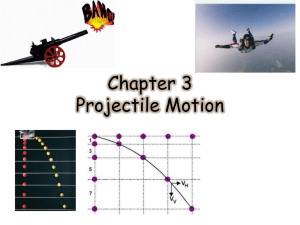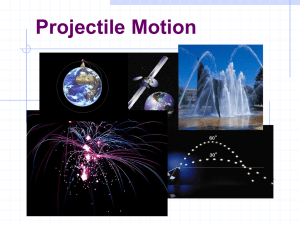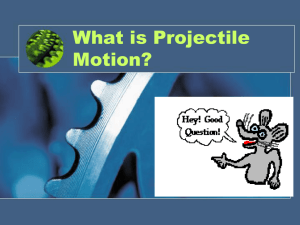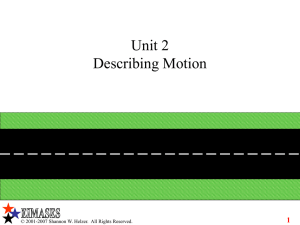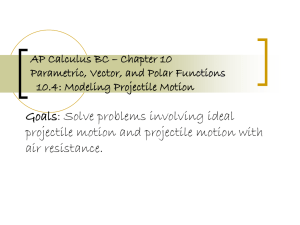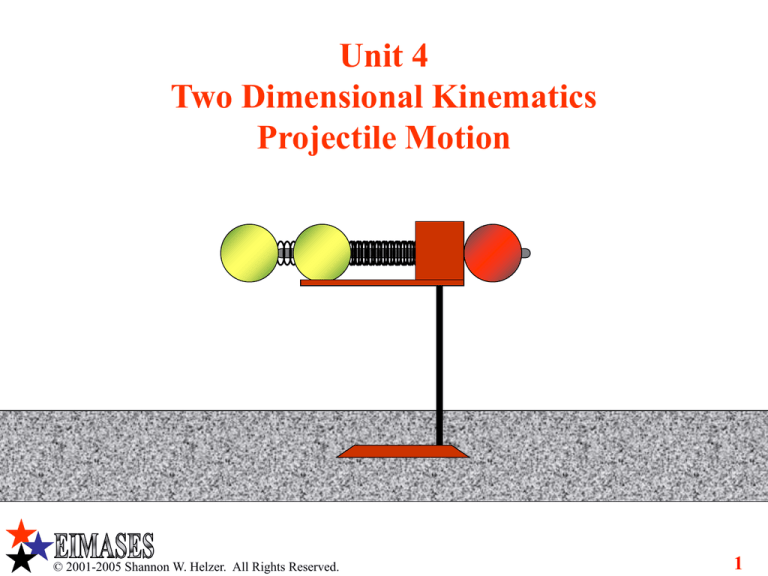
Unit 4
Two Dimensional Kinematics
Projectile Motion
© 2001-2005 Shannon W. Helzer. All Rights Reserved.
1
Projectile Motion
Projectile motion is the branch of kinematics that deals with motion in
two physical dimensions (x and y).
The link between these two physical dimensions is the temporal
dimension referred to as time.
In this unit we will study two types of projectile motion.
The first type of problem we will call the Full Range of Motion (FRM)
problems.
The second problem type will be called Table Problems (TP).
We will look at the problem types in the following slides.
Before looking at these problem types, we must make a change to our
Know Want Table.
© 2001-2005 Shannon W. Helzer. All Rights Reserved.
2
The Modified Know Want Table
When we do projectile motion
problems, we must make an alteration
to the Know Want table.
This change takes into account the
two dimensional nature of projectile
motion problems.
The kinematics equations will also be
modified.
Remember, the link between the two
dimensions is the time.
Horizontal
V
K
a
v1x
v2x
x1
x2
t
W
V
V
g
a
Vertical
K W
K
W
v
v1y 1
v2
v2y
d1
y1
d2
y2
t
t
v2 v1 at
v2 x v1x axt
v2 y v1y gt
v2 v1 2ad2 d1
v2 x 2 v1x 2 2ax x2 x1
v2 y 2 v1y 2 2g y2 y1
2
2
1 2
d 2 d1 v1t at
2
1 2
x2 x1 v1xt axt
2
© 2001-2005 Shannon W. Helzer. All Rights Reserved.
1 2
y2 y1 v1 y t gt
2
3
Table Problems
The below animation provides an example of a TP problem.
In these problems a projectile is launched horizontally from above ground level
with only an initial horizontal velocity (the initial vertical velocity is always
equal to zero).
Afterwards, the projectile falls to ground level.
The vertical acceleration is always -9.8 m/s2.
The horizontal acceleration is always 0.0 m/s2 (the horizontal speed is constant).
The graph of a TP problem appears as follows.
x v. y
60
y (m)
50
40
30
20
10
0
0
5
10
15
20
25
30
35
x (m)
© 2001-2005 Shannon W. Helzer. All Rights Reserved.
4
Table Problems and Time
The following experiment demonstrates the
relationship between time and the x and y
dimensions.
Watch the animation and observe the time it takes for
the yellow ball and the red ball to fall.
What did you notice about the times for these two
balls?
What type of projectile motion is represented by the
yellow ball?
What do you observe about the time it takes for the
yellow ball to fall in comparison to the time it took
for it to travel its horizontal distance?
The times are the same.
In table problems the time of fall is the same as the
time of horizontal travel.
© 2001-2005 Shannon W. Helzer. All Rights Reserved.
5
Projectile Motion Example
A fighter jet traveling at an altitude of 500 m at a speed of 112 m/s drops a bomb
on MeanyBot.
What type of a projectile motion problem is this one?
Some common questions you will be asked about TP problems are as follows.
What are the initial vertical acceleration and speed of the bomb?
What are the initial horizontal acceleration and speed of the bomb?
How many seconds before being directly overhead should the pilot drop the
bomb?
What is the horizontal distance between the plane and MeanyBot when the
bomb is dropped?
This problem is similar to WS 13 number 9.
© 2001-2005 Shannon W. Helzer. All Rights Reserved.
6
WS 13 Number 9
An airplane traveling 1001 m
above the ocean at 125 km/h is
to drop a box of supplies to
shipwrecked victims below.
How many seconds before being
directly overhead should the
pilot drop the box?
What is the horizontal distance
between the plane and the
victims when the box is
dropped?
© 2001-2005 Shannon W. Helzer. All Rights Reserved.
Horizontal
V
K
Vertical
W
V
a
g
v1x
v1y
v2x
v2y
x1
y1
x2
y2
t
t
K
W
7
Full Range of motion problems
The below animation provides an example of a FRM problem.
In these problems a projectile is launched from ground level with an initial
vertical and horizontal velocity.
Afterwards, the projectile returns to ground level.
The vertical acceleration is always -9.8 m/s2.
The horizontal acceleration is always 0.0 m/s2 (the horizontal speed is
constant).
The graph of a FRM problem appears as follows.
x v. y
y (m)
125
100
75
50
25
0
0
5
10
x (m)
© 2001-2005 Shannon W. Helzer. All Rights Reserved.
8
Projectile Motion Example
An archer fires an arrow at a target as shown.
What type of a projectile motion problem is this one?
Some common questions you will be asked about FRM problems are as follows.
How long will the arrow be in flight?
What will be the maximum height of the arrow.?
How far will the arrow travel horizontally?
In FRM problems you will need to find the “half time” of the projectile’s flight.
Remember, time is the link between the physical dimensions x and y.
This problem is from WS 13 number 5.
Before we do this problem, we will need to discuss the concept of half time and
the velocity triangle.
© 2001-2005 Shannon W. Helzer. All Rights Reserved.
9
Half Time
The most frequent questions asked for FRM problems are what
is the maximum height reached by the projectile and how far did
it travel horizontally (range).
In order to answer these questions, you must take into account
some basic facts of flight.
For instance, what is the vertical speed of the projectile at its
highest point (refer to WS 12)?
vy equals zero at the highest point.
Suppose the potatoes took 4.0 s to go up and back down.
At what time did they reach the highest point?
They reached the highest point at half time (2.0 s).
How much of the total horizontal distance did the potato fired at
an angle travel in 2.0 s?
Half of the horizontal distance.
To find the maximum height of the projectile you must find the
half time.
To find the range you double the
t half time.
© 2001-2005 Shannon W. Helzer. All Rights Reserved.
t1/2
10
Setting the Standard
When we do problems
involving kinematics, it is
important that we stick to a
standard when imputing data
into the know-want table.
This standard enables us to
take into account the vector
nature of acceleration,
velocity, displacement, etc.
These standards are
especially important in
multiple body kinematics
problems.
The slightest error with a
negative will result in
numerous miscalculations
and be very frustrating.
The following examples will
illustrate this point.
© 2001-2005 Shannon W. Helzer. All Rights Reserved.
11
The Velocity Triangle
In order to do FRM problems, we must find the
initial horizontal and vertical velocities of the
projectile.
In order to fid these velocities we will use the
velocity triangle.
Problem 5 from WS 13 states that an arrow is fired
with a velocity (v) of 49.0 m/s at an angle () of 30
with the horizontal.
This velocity has a horizontal component and a
vertical component.
These components can be found by using
trigonometry.
opp v y
sin
hyp v
adj vx
cos
hyp v
+y
v
vy v sin
vx v cos
© 2001-2005 Shannon W. Helzer. All Rights Reserved.
+x
12
WS 13 Number 5
An Arrow is fired with a velocity
of 49.0 m/s at an angle of 30 with
the horizontal.
How high will the arrow go?
How far will the arrow travel
horizontally?
+y
v
vy
vx
Horizontal
V
K
Vertical
W
V
a
g
v1x
v1y
v2x
v2y
x1
y1
x2
y2
t
t
K
W
+x
© 2001-2005 Shannon W. Helzer. All Rights Reserved.
13
Projectile Motion Example (WS 10 3)
A fighter jet traveling at an altitude of 500 m at a speed of 112 m/s drops a bomb on
MeanyBot.
What are the initial vertical acceleration and speed of the bomb?
What are the initial horizontal acceleration and speed of the bomb?
How many seconds before being directly overhead should the pilot drop the bomb?
What is the horizontal distance between the plane and MeanyBot when the bomb is
dropped?
This problem is similar to WS 13 number 9.
© 2001-2005 Shannon W. Helzer. All Rights Reserved.
14
The Jet Problem
A fighter jet traveling at an altitude of
500 m at a speed of 112 m/s drops a
bomb on MeanyBot.
What are the initial vertical
acceleration and speed of the bomb?
What are the initial horizontal
acceleration and speed of the bomb?
How many seconds before being
directly overhead should the pilot
drop the bomb?
What is the horizontal distance
between the plane and MeanyBot
when the bomb is dropped?
This problem is similar to WS 13
number 9.
© 2001-2005 Shannon W. Helzer. All Rights Reserved.
Horizontal
V
K
Vertical
W
V
a
g
v1x
v1y
v2x
v2y
x1
y1
x2
y2
t
t
K
W
15
WS 14 Number 2
An angry physics teacher is
launched from a cannon by his
students with a velocity of 18.8
m/s at an angle of 65.
How high above the ground did
the bald-headed grouch fly?
How far will he fly horizontally
before landing?
Horizontal
V
K
Vertical
W
V
a
g
v1x
v1y
v2x
v2y
x1
y1
x2
y2
t
t
K
W
v
vy
vx
© 2001-2005 Shannon W. Helzer. All Rights Reserved.
16
This presentation was brought to you by
Where we are committed to Excellence
In Mathematics And Science
Educational Services.
© 2001-2005 Shannon W. Helzer. All Rights Reserved.
17


